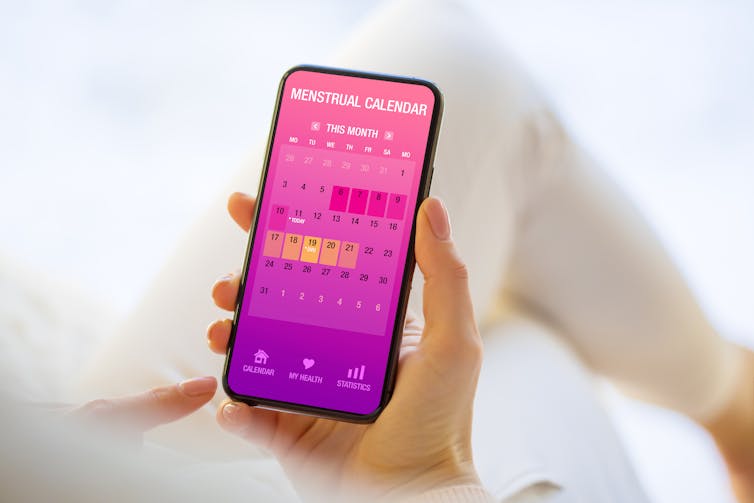From period trackers to pregnancy apps the industry is dominated by men. But Women’s health technology could be much more than that

From ovulation and reproductive trackers to contraceptive microchips, in recent years, there has been a surge of digital health products marketed to women. Known as “femtech” or female technology, this rapidly evolving global industry is expected to be worth US$60 billion (£44 billion) by 2027. As Lindsay Balfour reports, Research shows that despite an expanding market, many digital tools aimed at women are created, invested in and marketed by men. (Feature Photo -Artem Podrez/ Pexels)
Many of us are already used to apps or devices managing many aspects of our lives. And at a time when regular access to doctors has been limited due to the COVID-19 pandemic, it seems more women have turned to technology for their healthcare. Indeed, data company Fermata recently calculated that in the last six months of 2020 alone the number of companies under the femtech umbrella grew from 369 to 581, across 36 countries.
These digital health products are part of a much larger realm of “embodied technologies”, that allow users to have awareness of their bodily rhythms and functions in a way that seems safe, intimate, and empowering. Yet such products do not always offer an accessible privacy policy or commitment to protect women’s data from being sold on to third parties.
This is not just a challenge for startups. Recently in the US, the ovulation app Flo reached a settlement with the Federal Trade Commission after the regulator alleged the company shared data from almost 100 million users with third-party companies, including advertisers. Flo does not admit to any wrongdoing. In a statement, the company said it does not share information about users’ health without their permission. “We are committed to ensuring that the privacy of our users’ personal health data is absolutely paramount,” the statement added.

Research also shows that, despite an expanding market, many of these digital tools aimed at women are created, invested in and marketed by men. Indeed, recently the UK government launched a call for evidence in preparation for a new women’s health strategy. In this call, the then-secretary of state for health and social care, Matt Hancock, agreed that women’s health deserves a new approach. He said: “For generations, women have lived with a health and care system that is mostly designed by men, for men.”
Under-researched and underfunded
A 2021 global market analysis, by the Australia-based network FemTech Collective found digital health companies that focus on women’s health have only received 3% of investment deals in the US healthcare sector since 2011. This suggests that the women’s digital health industry is not considered a viable economic venture. This is despite the fact that women occupy the majority of healthcare roles, make most of the healthcare decisions in their households, and spend more money on healthcare products than men.
The report highlights that the women’s digital health industry doesn’t have the infrastructure, capital, or critical research that the male and gender-neutral markets do. And all too often the rules and laws developed around these products follow a “one-size-fits-all” model. This results in broad and inflexible policies that fail to consider the complexities and uniqueness of women’s health experiences.

This takes on even more significance when you consider that many embodied tracking devices or apps aim to manage, “improve” and monitor women’s intimate processes. Women have always been taught to feel estranged from and ashamed by their own bodies – or that their bodily functions need to be “managed”. And there is a risk that such technology, if not developed carefully, could further feed into this.
Beyond period and pregnancy trackers
While the most well-known femtech products include ovulation and pregnancy trackers, FemTech Collective’s report also acknowledges that “women are much more than their reproductive capabilities” and that “women’s health goes beyond the needs of fertility and reproduction”. Many of the current digital products designed for women also problematically assume a white, heterosexual, affluent, childbearing and able-bodied user. It’s clear more needs to be done to ensure investment and innovation in femtech is sustainable, accessible, and inclusive – and reaches the women who need it most.
But the good news is that in the push to develop more digital health products and services, women are demanding more involvement. Organisations such as FemTech Collective and Women of Wearables are transforming the industry landscape by creating networks that accelerate female investment and innovation while advocating for more diversity. These networks also help to connect women who work in femtech – from the designers and academics to the funders and marketers. This helps to position femtech not just as a “niche” part of the larger digital health field, but as a vibrant industry in and of itself.
Indeed, while it’s great that alternatives to the mainstream, male-dominated healthtech industry exist, it’s not enough for femtech products to simply be tools exclusively for “women”. This is why it’s vitally important that the industry takes other forms of marginalisation and women’s lived experiences into account.
Lindsay Balfour, Assistant Professor of Digital Media, Coventry University
This article is republished from The Conversation under a Creative Commons license. Read the original article.









